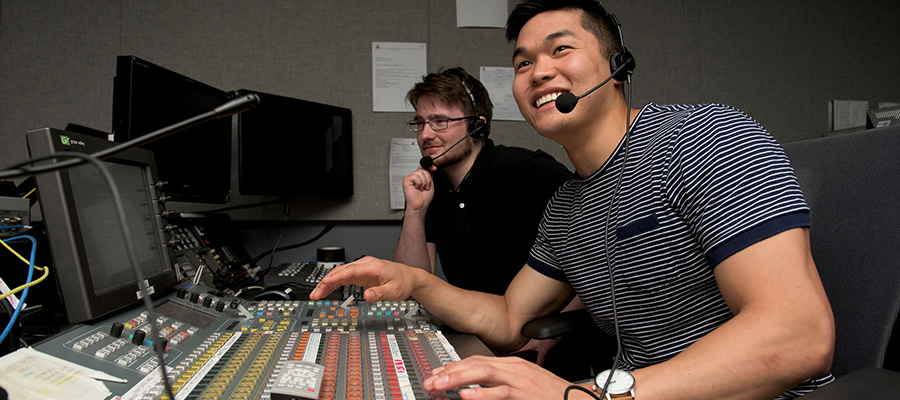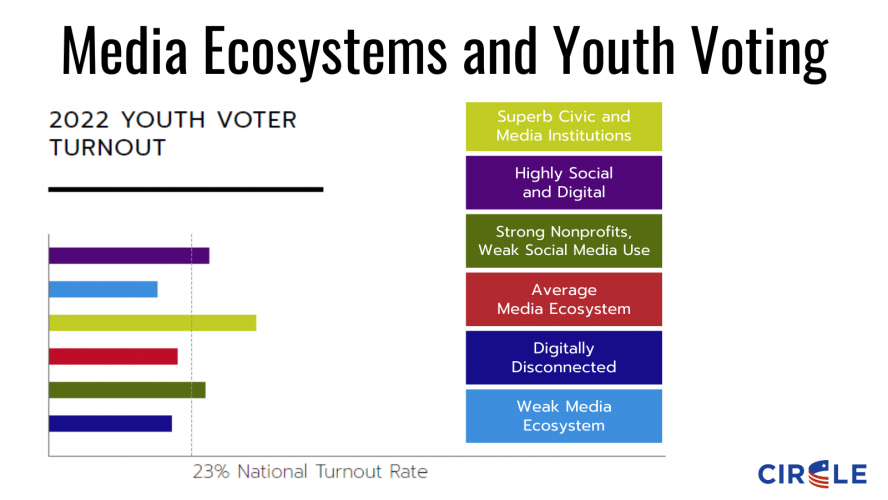Youth in Media for Democracy
The media, broadly defined, is an important part of the environment that influences whether and how young people participate in civic life. News in print, podcasts, on television, in social media, and cultural work shared online inform youth about the world and shape their understanding of how they can contribute to it—or whether they try. Social media is now a key way that young people are getting information about elections and politics, a way for youth to share their own media creations, and frequently a pathway to many forms of civic engagement.
Our research charts the connections between youth, media, and democracy. It examines how and where young people receive and create messages about elections and civic life, where there are information gaps that may prevent all young people from feeling well-informed and supporter, and what it means for a community to have a strong media ecosystems that is conducive to strong, equitable youth participation.

Media Ecosystems and Youth Voter Turnout
Journalists and the 2024 Election
Local News and Elections
Did You Know? Fast Facts on Youth + Media
90% Consume Local News
According to CIRCLE's 2020 post-election survey, 9 out of 10 young people watched or read local news, busting the myth that young people aren't paying attention and highlighting the critical role local media can play informing and engaging youth.
4% Have Strong Media Ecosystems
Our analysis of county-level conditions for young people to learn about elections and civic life finds that only 4% of U.S. counties have superb media and supportive civic institutions—and that those are some of the places with the highest youth voter turnout in the U.S.
80% Are Empowered by Media Creation
A ccording to CIRCLE's 2022 teen survey, when teens create media and post content online about issues and politics, more than 4 in 5 say they feel more informed and feel like their voices are more powerful. But not all teens get the chance to learn media creation skills.
In Depth: Youth, Media, and Democracy
Young people get information about elections, politics, and issues in their communities from a wide range of sources. At the same time, many youth still report that they do not learn or know enough to feel fully informed and supported in their civic participation. That means there's lots of opportunities for media, broadly defined, to expand and improve how they reach young people.
- A Diverse Media Diet: While many assume youth only see or seek out political information online and on social media, our research shows that TV news, print media, podcasts, and radio are still major potential sources of information about elections and voting. Learn more
- Lack Of Information Still a Major Barrier: More than 1 in 5 youth (21%) who didn't vote in 2022 blamed a lack of information as the primary reason why they didn't cast a ballot. Learn Learn more
- More than Lower Turnout: Our analysis that clusters youth based on their level of access to political information and political homes shows that those without access to both feel much less qualified to participate in politics. Learn more
It's not enough for information about elections and voting to be technically available to young people. Youth often need support finding that information, connecting it to their lives and communities, and understanding how they can wield it to take action on issues they care about. That's why a strong media ecosystem includes more than just news or social media content: it must also feature accessible structures and institutions, like local nonprofits, that can directly and indirectly help youth move from information to action.
- Elements of Media Ecosystems that Connect to Youth Voting: Our county-level analysis of different communities' media ecosystems highlights how few places in the U.S. have strong environments for youth to learn about and act on political information—but also how the presence of different institutions and organizations can make up for the relative absence or weakness of others. Learn more
- From News Attention to Action: Our in-depth analysis found that membership in civic organizations strongly explained the positive association between paying attention to the news and likelihood to take direct action on an issue. Learn more
Young people don't just consume media, they create it. Whether they're making and sharing GIFs, Snaps, and TikToks, or partnering with local media organizations on news stories, youth media creation is an critical way for young people to make their voices heard, bring their perspective to public conversations, and contribute to civic life.
- Youth Are Politically Active Online: According to CIRCLE's 2020 post-election survey, nearly half (45%) of youth said they have created, shared, or engaged with political content online—and that some youth of color are even more likely to create online media. Learn more
- Media Making Helps Build Confidence: CIRCLE's 2022 teen survey revealed that more than 80% of teens feel better informed and more confident about civic participation when they create media about issues and politics. Learn more
- Media Literacy Is Necessary but Unequal: Young people need opportunities to learn and practice these skills, which means that media literacy education must teach more than media consumption, it must also teach media creation. But there are major inequities in who has these educational opportunities. Learn more
The information gaps, inequities, and missing opportunities for the media—broadly defined—to fully support and engage youth require shifts and collaborative efforts from stakeholders across different areas of media ecosystems.
Our recent research, including the 2022 CIRCLE Growing Voters framework, offers specific insights and recommendations:
Literature Review: Youth and Media
Researchers have been studying young people's relationship with the media for decades, and there is a strong body of evidence about young people's engagement with—or lack thereof—with "traditional" media, the importance of media literacy, and youth representation in the media. More recently, researchers have begun to focus on the prevalence and the benefits of youth media creation, especially on digital platforms, and its connections with civic development and participation.
Our research in this area informs and is informed by this scholarship on young people's engagement with the media.


